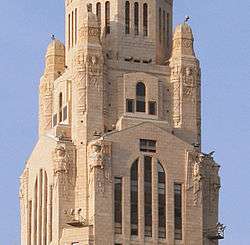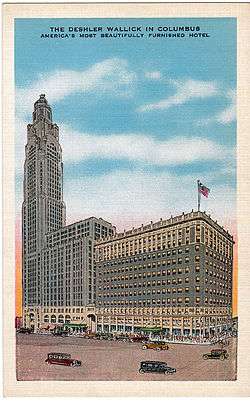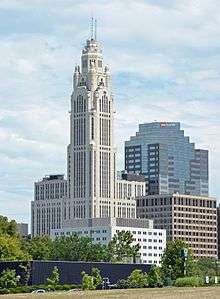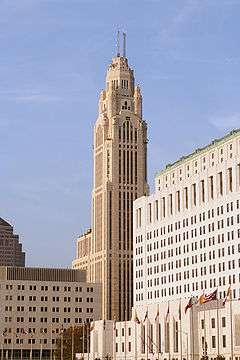LeVeque Tower
|
American Insurance Union Citadel | |
|
Front of the building, with the Supreme Court building in the foreground | |
  | |
| Location |
50 West Broad Street Columbus, Ohio |
|---|---|
| Coordinates | 39°57′44″N 83°0′7″W / 39.96222°N 83.00194°WCoordinates: 39°57′44″N 83°0′7″W / 39.96222°N 83.00194°W |
| Area | 0.5 acres (0.20 ha) |
| Built | 1924 |
| Architect |
C. Howard Crane; John Gill & Sons |
| Architectural style | Art Deco, Modernistic |
| NRHP Reference # | 75001398[1] |
| Added to NRHP | March 21, 1975 |
The LeVeque Tower is a 47-story Art Deco-style building in Columbus, Ohio. Located at 50 West Broad Street (US 40), it was the tallest building in Columbus from 1927 until 1974 when the Rhodes State Office Tower was completed. The LeVeque Tower is 555 feet 6 inches (169.32 m) tall, which at the time of its completion made it the tallest building between New York City and Chicago and the fifth tallest building in the world. It was meant to be built exactly one half-foot taller than the Washington Monument in Washington D.C.
History
Construction
The LeVeque Tower was commissioned by the American Insurance Union and originally called the American Insurance Union Citadel (AIU Citadel for short). The term "citadel" was chosen for its strong and enduring connotations, which the AIU wanted to convey to the public. Its creation was spearheaded by the leader of the AIU, local magnate John J. Lentz. It was designed by architect C. Howard Crane. Its construction cost approximately $8 million.[2]
Its construction occurred along with a massive revitalization of the riverfront area in downtown Columbus after much of the area had severe problems with flooding. In addition to the tower, a new Columbus City Hall, the 14-story Ohio Courts Building, and the widening of the Scioto River were all undertaken during the same period. The tower was originally only going to be around 480 feet (150 m) tall, but for promotional purposes the leaders of the AIU decided to have the architect augment the original design, so the tower would be 555.5 feet (169.3 m) tall, or 1 foot (0.30 m) taller than the Washington Monument. This aspect of the building was often played up in marketing campaigns. Today, using better measuring devices, it is now known the Washington Monument is 555 feet 5 1⁄8 inches (169.294 m) tall, making the tower only 7⁄8 inch (22 mm) taller than the Washington Monument.

The tower is a steel-frame building covered in glazed architectural terra-cotta tiles with an oak-bark texture. The building is extremely stable because its foundation goes all the way down to bedrock. C. Howard Crane devised a system derived from the method used to build the foundations for the towers of the Brooklyn Bridge. Caissons were sunk into the ground, and workers dug out the dirt from inside their pressurized walls. This method was necessary due to the tower's proximity to the Scioto River, which meant ground water was only a few yards below the surface. This method was, however, very costly. Both from the standpoint that the equipment and power needed to run it (air compressors, decompressors) but also because working in a pressurized environment is very taxing on the workers. It was also time-consuming to get workers ready to work, and they also had to go through a process of depressurization to prevent decompression sickness. All said, some workers would only spend 30 minutes actually digging before heading back up to the surface. The foundation resulted in the longest leg of the building process.
Five people lost their lives during the construction of the tower. One fell from the steel framing. Four others died during the construction of the foundation when a pocket of noxious gas was opened during digging. The gas overwhelmed the workers, and they fell into the hole of the foundation.
Originally, the building's exterior featured a large number of sculptures. However, for legal and safety reasons much of it had to be removed because the terra-cotta began to crumble and fall to the street. Lost sculptures include four 18 feet (5.5 m) eagles at the corners of the building at the 36th floor and four 20 feet (6.1 m) statues of colossus and youth on the sides of the building at the setback of the 40th floor; these were actually removed, so Mr. LeVeque could have a view from his office. The spaces left by the departed sculpture serve as the bases for lights used to illuminate the tower.
Changing function and ownership

Originally the two wings of the building were used as a 600-room addition for the Deshler-Wallick Hotel, the city's leading hotel at the time and one of the world’s largest. The hotel's large mirrored ballroom was also contained in the LeVeque Tower. Part of this space now serves as passage from an adjacent parking garage into the lobby of the tower. The hotel space in the tower was converted into offices and the Deshler Hotel, later operated by Hilton Hotels, was demolished in 1970.
Due to the Great Depression and the subsequent high cost of the tower, the American Insurance Union went bankrupt, and sold the building in order to pay off unpaid policies. The tower was purchased by John Lincoln and Leslie L. LeVeque in 1945 for a fraction of the amount it cost to erect and also a fraction of what was owed to policy holders, subsequently those holding policies never received the full amount they were owed. (LeVeque was the designer of an automatic pinsetter which became known as the Columbus pinsetter. LeVeque died in a plane crash in 1946. The patent for his pinsetter was later purchased by AMF.)
An observation deck was operated through the 1960s where visitors could travel to the top of the tower for a small fee. The deck was closed with the addition of antennas to the top of the tower and the space was converted into a luxury penthouse apartment.
The Lincoln-LeVeque Tower was added to the National Register of Historic Places in 1975. In 1977, the name was officially changed to the LeVeque Tower. The building changed hands to Lennar Properties in 2004, and then again to the new owners Finsilver/Friedman Management, a Michigan-based regional developer and property manager.
Throughout its history the building has been noted for the bright and elaborate lighting of its tower. The original design placed the signal lights on the four turrets of the tower. Since the 1980s the tower has had the capability of being lit in a variety of colors. It is normally lit in white, but color is added frequently for special occasions. During the month of February, the tower is lit red in support of Go Red For Women, the American Heart Association's national movement raising awareness for heart disease. In late April and early May, the tower is pink for The Columbus Race for the Cure. During the Christmas season, the tower is red and green, while it is simply green for St. Patrick’s Day. It was lit red, white, and blue for the Fourth of July holiday during the Columbus' Red, White, and Boom festivities and for an extended period of time following September 11, 2001. For the first time in September 2008 the tower was lit in teal for Ovarian Cancer Awareness.
The LeVeque Tower complex continues to be home to a variety of businesses and offices, including, at its base, the Palace Theatre.
Renovation
A $26.7 million renovation is planned for the LeVeque Tower. Plans include repairing the crumbling, cracking terra cotta skin of the building and restoring its art elements of cherubs and guardian angels, shields and garlands. The renovation will create high-rise apartments and revitalize office space in the base. The State of Ohio will provide $5 million in tax credits for the renovation.[3]
American Insurance Union

The American Insurance Union was founded in 1894 by members of the Fraternal Mystic Circle who were unhappy with that organization. In addition, many of the founders were members of the National Union, the Knights of Pythias, the Oddfellows and the Masons. The organization incorporated the elements of the National Union plan and other fraternal societies. Unlike other fraternal societies of the era, the Union never had to adjust its rates to a more actuarially sound basis. Hence, the A.I.U. became known as the fraternal order that was "started right".[4][5]
The Union was limited to people ages 15–49 who lived in the healthful areas of the country and were engaged in a "preferred occupation". It was governed in a manner typical of fraternal orders of the era with local and State Chapters governed by a Supreme or National Chapter.[6] In 1923 it had 110,370 members in 904 lodges in 27 states.[7]
References
- ↑ National Park Service (2009-03-13). "National Register Information System". National Register of Historic Places. National Park Service.
- ↑ "LeVeque Tower, a Downtown icon, changes hands". The Columbus Dispatch. March 11, 2011. Retrieved 2012-03-02.
- ↑ "LeVeque Facelift". The Columbus Dispatch. July 7, 2012. Retrieved July 7, 2012.
- ↑ Stevens p.123
- ↑ Fraternal Monitor April 1922 Vol. XXXII #9 p.9
- ↑ Stevens p.123
- ↑ Preuss p.21
Further reading
- Perkins, Michael A. (2004). Leveque: The First Complete Story of Columbus' Greatest Skyscraper. Author House. ISBN 9781468518962.
External links
- CAPA venues–Palace Theatre history
- Columbus Business First: “Papers clarify LeVeque Tower owner change”
